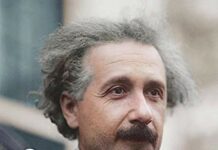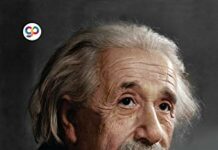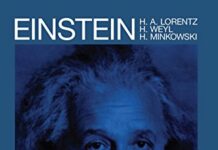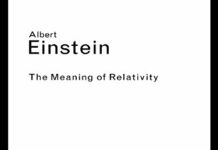
Ebook Info
- Published: 2013
- Number of pages: 176 pages
- Format: PDF
- File Size: 7.04 MB
- Authors: Albert Einstein
Description
Where does humanity fit in the cosmos? Albert Einstein, one of history’s towering scientific geniuses, explores this fascinating subject in a unique anthology―featuring some of his most inspirational writings, including rare materials from the Einstein archives―illustrated with mind-bending photographs of the universe. Einstein’s deep intuitive insight into the workings of nature couples with his probing, philosophical mind. Here, scientists, artists, musicians, spiritual seekers, and Einstein fans will discover his beliefs about God, the afterlife, the nature of free will and existence, art and creativity, science, world peace, and how we can free ourselves from the delusion of separateness from the universe.
User’s Reviews
Editorial Reviews: Review “An eye-opening anthology of the great scientist’s thoughts on ethics, spirituality, and the nature of existence.” – SCIENTIFIC AMERICAN Book Club and SCIENCE FICTION BOOK CLUB (SFBC) From the Author “In this awe-inspiring little book, the authors have chosen to focus on Einstein’s spiritual and socially responsible side. It is evident that this work was a labor of love, carried out over many years of researching, collecting, and obtaining permissions to use quotations and photos. The end result is worthy of their labor. Einstein’s words are juxtaposed with astounding photographs of the universe he loved, most of them taken by NASA’s Hubble space telescope. The endorsements for the book are fabulous, too: from an Apollo astronaut who walked on the moon; from James Van Allen, the late physicist of radiation belt fame, who wrote the foreword; and from the Dalai Lama himself, among others. Those who are interested in Einstein’s “softer” side will be uplifted by reading this book. Scientists and nonscientists alike will eagerly turn the pages to see what comes next.” Alice Calaprice, author of The Ultimate Quotable Einstein, is a former senior editor at Princeton University Press in charge of The Collected Papers of Albert Einstein. From the Inside Flap Albert Einstein was one of the most influential scientists of all time, but he was also an inquisitive philosopher who had many inspiring thoughts about the meaning of life, the nature of free will and existence, and our place in the cosmos he studied so closely. Through these spectacularly photographed pages, you’ll take a thrilling journey across the universe discovering Einstein’s cosmic view.This inspiring book reveals Einstein’s ethical and philosophical ideas through quotes from many different sources―essays, books, letters, and interviews, including rare materials. These writings have been organized in such a way as to give you insight into Einstein’s beliefs, as well as a sense of the man. He covers such topics as The World as I See It, Religion and Science, Morality and Values, Conscience, World Peace, Art and Creativity, Imagination, Curiosity, Nature, and more. Einstein’s words are beautifully illustrated with breathtaking photos of space selected to inspire wonder and awe that we are an integral part of the magnificent cosmos. From the Back Cover “There are moments when one feels free from one’s own identification with human limitations and inadequacies. At such moments one imagines that one stands on some small spot of a small planet, gazing in amazement at the cold yet profoundly moving beauty of the eternal, the unfathomable. Life and death flow into one and there is neither evolution nor destiny; only being.” ― Albert Einstein What was one of the most famous scientist’s views on our place in the universe? Take a rare look at Albert Einstein’s ethical and philosophical ideas through his own words, richly illustrated with stunning photos of the universe, ranging from our planetary neighbors to the edge of time and space. About the Author Magda Ott studied German, Slavic, and American Indian literature at J.W. Goethe University in Frankfurt and completed her studies of literature at Maharishi International University in Washington, DC, and Fairfield, IA. Walt Martin graduated from Maharishi International University (now Maharishi University of Management) in Fairfield, Iowa with a BA in Interdisciplinary Studies with a concentration in education. Martin has been instrumental in local environmental reforms that have been praised by the EPA and have led to national policy reform. Read more
Reviews from Amazon users which were colected at the time this book was published on the website:
⭐This is one of the wisest and most beautifully illustrated books I own. It’s so nice to have such an elegant snapshot of such a beautiful, multidimensional, and complex human being as Einstein. I would reccomend this to anyone who wants a good look into this brilliant man, who he was, and what he sorts for and believed in.
⭐Gorgeous photos of the universe accompany short and extensive quotes by Einstein on moral, religious and social issues. The book isgreat bed time reading for inspiration. Fun to get into the mind of Einstein.
⭐Great quality.
⭐Wonderful book! Excellent shape and quick shipping! Arrived well ahead of schedule. Everything as promised. Thank you so much!
⭐Going to a lecture today on this book. Good read.
⭐Five star
⭐great read
⭐Good read!
⭐I must admit to having mixed views on this 151 page book (no index, incidentally).The text is a mixture of Einstein’s quotes and contributions from the two compilers, together with a plethora of colour images, mostly taken with extra-terrestrial imaging devices.One has to take on trust the quotes from Einstein himself; the rest is a mixed bag.As for the captions. Some of these are plainly inaccurate. For example, pages 70/71. Arcturus within its constellation Bootes is there (far right), together with Corona Borealis (left), but no “Big Dipper” (Plough), which is to the right and off-frame. Yes, a section of the Milky Way is there plain enough with first magnitude star Altair top, middle left. As to Jupiter? Possibly down the bottom middle in Sagittarius. But these captions need to give more detail as to date and instrumentation.On page 29 it is stated the first magnitude star, Antares, (alpha Scorpii) that “It has spent most of its short life as a highly luminous blue supergiant star . . .” On page 123, Antares is referred to as a red supergiant star. Here there is also confusion over spelling with reference to the two constellations Ophiuchus (rendered as “Ophiuhci”) and Scorpius. To the uninitiated it is not clear exactly where the “red” Antares fits into this photograph, and the globular cluster (M 4) lower right, is not mentioned.The caption of page 113 has a priori reference to “big bang”. It should be noted that Einstein was not over enthusiastic about this hypothesis.Personally, I do not find these images attractive – far too mocked-up for the occasion. I have seen far more subtle and penetrating images from ground-based telescopes, many of which I have secured myself throughout a career in astronomy lasting over sixty years.So, so!
⭐This is a beautifully produced little book in which the editors have collected some of Einstein’s thoughts and writings on a diverse range of subjects and put them together with some wonderfully awe-inspiring pictures of the Universe he did so much to explain. But fear not, fellow scientific innocents – there is barely a mention of relativity and nary a formula in sight. Instead, this book introduces us to his convictions and beliefs – about pacifism, the social responsibility of scientists and his desire to see the replacement of the nation state with an overarching world government.But most of all the book concentrates on his spiritual views or, as he calls it, his ‘cosmic religion’. The tendency of atheists to quote Einstein’s discoveries as proof that there is no god angered him in his lifetime; and his writings, as given in this book, show that while he didn’t believe in conventional religion – a ‘personal’ God – he was a deeply spiritual man who felt that the harmony and perfection of the universe argued just as much against atheism.”My religiosity consists of a humble admiration of the infinitely superior spirit that reveals itself in the slight details we are able to perceive of the knowable world with our frail and feeble minds. That deeply emotional conviction of the presence of a superior reasoning power, which is revealed in the incomprehensible universe, forms my idea of God.”The writings the editors have chosen show him as a man who gave the subject of religion and religiosity much thought, and his expressed opinions, while they may not please either the very religious or the extreme atheist, are reasoned and coherent. The given extracts suggest that he believed in a Creator, but one who does not then involve himself in the individual affairs of man – does not punish or reward. As a consequence, man is responsible for his own morality; and that belief feeds into all his other views – of the responsibility of scientists to ensure that their actions do no harm, of the evils of war, of his hatred of militarism.My cynical nature couldn’t prevent me wondering how carefully the extracts had been selected to support the emphasis the editors clearly wished to place on the two main subjects; that science and religion should be able to co-exist – are in fact, co-dependent; and that all nations should give up their atomic weapons. There is an afterword revealingly written by two former co-presidents of the International Physicians for the Prevention of Nuclear War, Ron McCoy and Gunnar Westberg. However I have no reason to think that Einstein’s views have been misrepresented and there is a bibliography should any reader wish to look further.But while the written content is interesting, (if occasionally a little repetitive), the illustrations are both lavish and superb. Nearly every second page has a glorious colour picture of some aspect of the universe, with a little explanatory note, and there are many double page spreads too. I’ve added a few customer images but my photos don’t do the book justice. The book is beautifully made, with carefully selected typefaces on gorgeous quality paper. I have no choice – I have to use the dreaded words ‘Perfect Christmas Gift’. A joy to possess.
Keywords
Free Download The Cosmic View of Albert Einstein: Writings on Art, Science, and Peace in PDF format
The Cosmic View of Albert Einstein: Writings on Art, Science, and Peace PDF Free Download
Download The Cosmic View of Albert Einstein: Writings on Art, Science, and Peace 2013 PDF Free
The Cosmic View of Albert Einstein: Writings on Art, Science, and Peace 2013 PDF Free Download
Download The Cosmic View of Albert Einstein: Writings on Art, Science, and Peace PDF
Free Download Ebook The Cosmic View of Albert Einstein: Writings on Art, Science, and Peace





